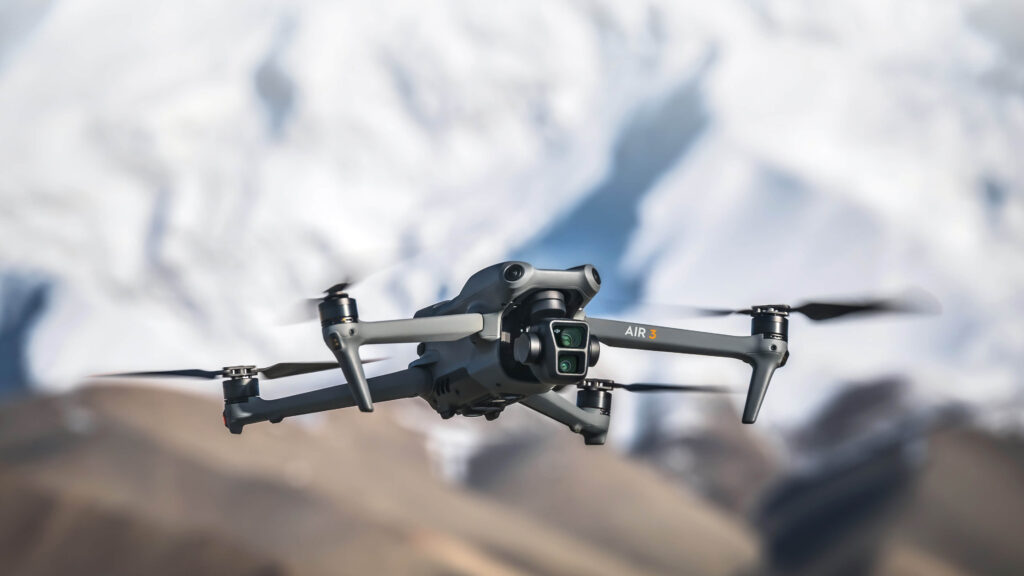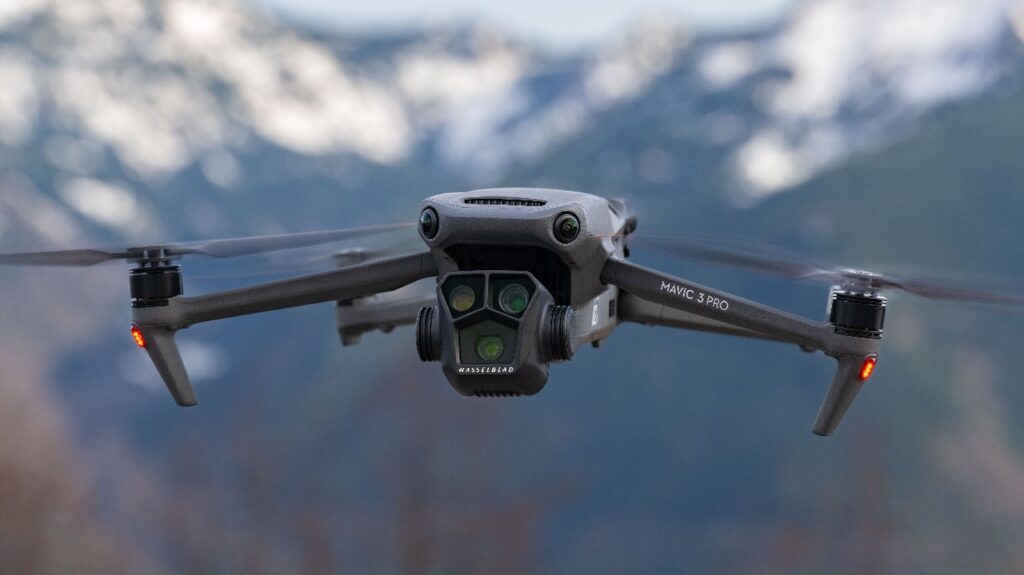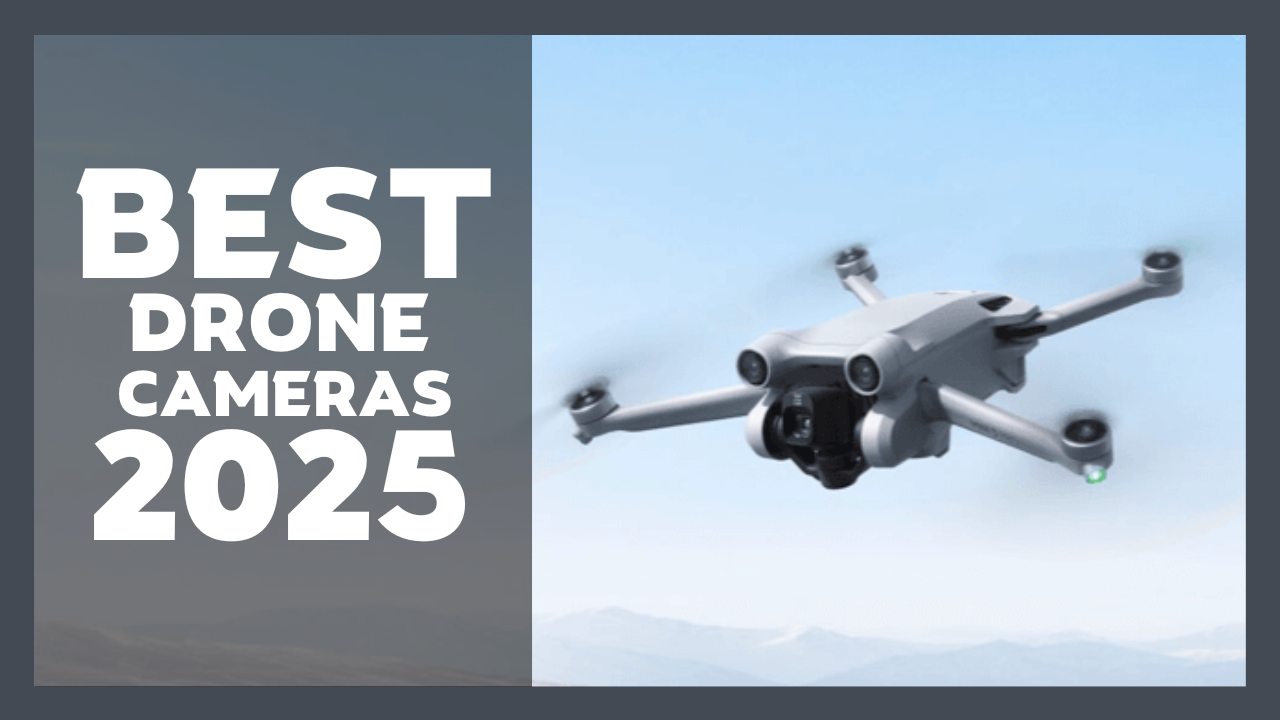We’ve tested all of the best drones over the last decade, from beginner-friendly models to flagship quadcopters. And they’ve come on a long way since the DJI Phantom series made flying cameras available to consumers – once niche and expensive, now anyone can get off the ground and shoot impressive aerial footage. As a result, the best drones have become a key tool in the arsenal of content creators and filmmakers.
Table of Contents
- No 1 DJI Air 3
- No 2 DJI Mavic 3 Pro
- No 3 DJI Mini 3
Top 3 Best Drone Cameras In 2025
No 1 DJI Air 3

The DJI A3 is a formidable competitor for hobbyists and content producers alike since it offers mid-range drones a new degree of versatility and capability. The Air3’s dual camera system, which includes a wide angle and a 3X telephoto lens, is what immediately draws attention to it and enables users to take breathtaking pictures from various angles.
With a flight duration of up to 46 minutes, the Air3 enables prolonged operation in the air, enabling more shots, and its 48 MP camera produces amazing clarity and crisp images. Its 4K 60 frames per second video recording makes sure that even fast-moving objects are caught flawlessly.
time to set up the ideal photo without having to worry about the battery dying in midair Intelligent flying modes offered by DJI, include Focus track and may By automating your creative process, master shots make it simple for both novices and experts to produce cinematic-quality film.
The DJI Air3 is ideal for adventure seekers because of its sturdy design and wind resistance capabilities, which enable stable flight. Another noteworthy feature is its upgraded obstacle avoidance system, which now covers all directions, significantly improving safety and ease of use even in complex environments.
flying despite difficult weather conditions Overall, the DJI Air3 strikes a balance between high-end features and intuitive functionality, making it one of the best options in its class for anyone serious about AAL photography or videography, whether for hobby or professional use.
The new 04 transmission system off offers a solid connection with up to 20 kilm range, giving you peace of mind that you can fly farther without losing signal.
Pros
- Dual cameras
- Excellent wind resistance
- Generous 46-minute flight time
- Already excellent safety features improved further
Cons
- C1 European rating
- Fixed aperture is bad news for ND filter users
- Large protruding camera likely to suffer in case of accidents
No 2 DJI Mavic 3 Pro

The DJI Mavic 3 Pro At the heart of the DJI Mavic 3 Pro’s design is a dual camera setup with a 43 seos Hasselblad sensor and a 12mp telephoto lens, which enables creators to capture amazing aerial shots with stunning detail and color accuracy. This drone is a game-changer, combining cutting-edge technology with exceptional performance.
For both professional videographers and photography aficionados, the Hasselblad camera offers unmatched quality with 5.1k video resolution and up to 20 MP photographs. The telephoto camera, on the other hand, is ideal for This drone is perfect for long-distance flight and exploration since it has a 28x hybrid zoom for zoomed-in photos and a patented o03 plus transmission system that assures a crystal-clear life feed up to 15 kilometers.
For those who are interested in clever features, the flight performance is equally stellar, with a battery life of up to 43 minutes on a single charge and a strong omnidirectional obstacle detecting system that guarantees safe and accurate flying even in complicated surroundings. The Mavic 3 Pro does not let users down; it has advanced autonomous flying modes like active track 5.0 Master shots and fast shots that make it easy for even novices to record cinematic video.
Even under difficult circumstances, the drone’s enhanced wind resistance and GPS capabilities make it very responsive and stable. Furthermore, the updated intelligent battery technology reduces downtime in between flights by charging more quickly and extending flying duration.
The DJI Mavic 3 Pro establishes a new standard for drone technology by combining robust hardware and user-friendly software that appeals to creators of all skill levels, whether you’re a professional filmmaker or an enthusiastic drone enthusiast. With its excellent camera quality and cutting-edge safety features, the Mavic 3 Pro is without a doubt one of
Pros
- Three useful cameras
- Excellent image quality
- Solid safety features
Cons
- C2 European rating
- Not everyone will need three cameras
- Slightly reduced flight times
No 3 DJI Mini 3

DJI mini3 is a game changer for anyone looking to elevate their aerial photography without diving into complex heavyweight drones. Weighing under 249g, it stays within the limits that are exempted from registration requirements in many countries, making it a hassle-free option for hobbyists and professionals alike.
Despite its compact size, this drone packs impressive features such as a 4K camera with HDR and a 3is gimbal that ensures smooth and stable footage even in windy conditions. The mini3’s user-friendly controls let you to explore and record breathtaking video without having to worry about charging all the time.
It is ideal for both novice and seasoned pilots due to its intelligent flying modes, which include fast shots and return to home. For creators who desire high-quality aerial photos without the vlore complication,
The DJI mini3 delivers a wonderful blend of performance, portability, and value with its improved obstacle recognition and accurate GPS location, which increased safety and simplicity of use during flight even in challenging terrain.
Pros
- More affordable than the Mini 3 Pro
- Great image quality
- Small and lightweight
Cons
- No collision avoidance
- 4K video limited to 30fps
- No subject tracking
What are laws around flying a drone?
Drone laws exist to ensure a high level of safety in the skies, especially near sensitive areas like airports and national parks. They also aim to address privacy concerns that arise when camera drones fly in residential areas.
In several regions, such as the United States, drones weighing less than 250g are exempt from registration with civil aviation authorities. While registration might not be mandatory, it’s still necessary to follow local drone laws. This includes the requirement to keep your drone within sight at all times when airborne.
Different countries have different rules. Previously, in the UK, drones weighing less than 250g were exempt from registration. This has changed: owners of any camera-equipped drone must now register their aircraft with the Civil Aviation Authority and obtain an Operator ID. This registration carries an annual fee of £11 for individuals aged 18 and above.
If your drone exceeds 250g in weight, you will also require a Flyer ID. To obtain this, you need to pass an online test featuring 40 multiple-choice questions. The answers can be found in the Drone Code and are intended to promote safer flying practices.
For drones weighing less than 250g without a camera, neither ID is necessary. That said, you still need to comply with the UK’s drone laws. According to the Drone Code, this means maintaining visual contact with your drone, flying no higher than 120m above the ground, staying at least 150m away from populated areas, and avoiding restricted airspace, typically found near airports.
Please be aware that we may receive a commission if you buy something after clicking on the links in our stories. This helps to fund our work. Thank you for your support and attention. Feel free to look around further to find out more about how these commissions support our work. Top Great Reviews

